Composite Insulator Defect Identification Method Based on Acoustic–Electric Feature Fusion and MMSAE Network
Abstract
:1. Introduction
- Electromagnetic wave and ultrasonic live detection tests of composite insulator defects are carried out. Six typical defect insulator samples are made in the laboratory, and a defect detection test platform is built. The electromagnetic wave spectrometer and ultrasonic detector are used to measure the electromagnetic wave and ultrasonic signal radiated by the unpressurized background noise, the intact insulator and the defective insulator in a certain distance. FFT is used to analyze the spectral characteristics of electromagnetic wave signals, and the ultrasonic signal is analyzed by a power spectrum and n-S map. Combining electromagnetic wave and ultrasonic detection methods can scientifically and effectively reflect different types of insulator defects.
- A composite insulator defect diagnosis algorithm based on acoustic–electric feature fusion and multi-scale perception multi-input of a stacked auto-encoder network is proposed. The peak and average value spectrum of electromagnetic waves, an ultrasonic power spectrum and n-S map are extracted by a stacked auto-encoder and are reduced to similar dimensions to avoid one signal occupying too much weight and weakening the influence of other signals on the results. The above data are fused as the input of the multi-scale perception multi-input network. By stacking multiple such structures, data information can be extracted on multiple scales without increasing the number of network parameters, avoiding overfitting caused by too many network layers and improving the accuracy of classification. By comparison, it is proven that the detection accuracy of the proposed method is obviously better than that of a single-feature input source and traditional ANN method.
- Composite insulator defect diagnosis software is developed, and the aging composite insulators replaced on-site are tested and verified. Based on the proposed acoustic–electric feature fusion and MMSAE network, a composite insulator defect diagnosis software is developed in PYQT5 and Keras environments. The software detection and dissection analysis of ten 500 kV aging composite insulators replaced on-site are carried out, which proves the accuracy of the proposed method and software. It is helpful to comprehensively study and judge the operation state and defect type of composite insulators on transmission lines, and this has practical engineering significance.
2. Acoustic–Electric Features Test of Composite Insulator Defects
2.1. Test Circuit
2.2. Composite Insulator Defect Simulation
2.3. Experiment Results and Analysis
2.3.1. Processing Method and Result Analysis of Electromagnetic Wave Data
- The peak spectrum and average spectrum of conduction defects have higher amplitude at 0~80, 120~200, and 450~550 MHz. The peak spectrum of 350~450 MHz is similar to that of an intact insulator, whereas the average spectrum is distinct.
- The peak spectrum and average spectrum of suspension defects in the range 0~80 MHz are not as high as those of conduction defects, but they are still relatively obvious. The peak spectrum and average spectrum of 150~200 MHz have higher signals. The peak spectrum of 350~450 MHz and the average spectrum of 150~400 MHz are obviously different from the intact insulator signal.
- Since there is little difference between the two types of frequency spectrums of the leakage tracking defect and that of the intact insulator, it is assumed that there is no obvious discharge in the defect.
- The average spectrum and peak spectrum of the water vapor entry defect exhibit intermittent discharge peaks at 40, 160, 360, and 450~550 MHz. The average spectrum generally has a richer signal distribution and higher amplitude in the 50~600 MHz band.
2.3.2. Processing Method and Result Analysis of Ultrasonic Data
3. Composite Insulator Defect Identification Method Based on Acoustic–Electric Feature Fusion and MMSAE Network
3.1. Overall Network Architecture
3.2. MMSAE Network
3.3. Acoustic–Electric Feature Fusion Method
3.3.1. Electromagnetic Wave Spectrum Feature Extraction
3.3.2. Ultrasonic Feature Extraction
3.3.3. Feature Fusion and Classification
3.4. Diagnostic Results and Analysis
3.4.1. Fusion Diagnosis Results and Analysis
3.4.2. Comparison and Analysis of MMSAE and ANN Results
- The training effects of the two networks are compared. As training sample sets, the fusion, ultrasonic, and electromagnetic wave data are utilized. The total accuracy obtained by training on the MMSAE model was 99.17%, 80.83%, and 97.5%, respectively, and that on the ANN was 96.67%, 73.30%, and 95.83%, respectively. It demonstrates that the training effect of MMSAE using any data is superior to that of ANN when using the same data.
- Comparing the classification results of different training data, the fusion method shows the best effect on the two models, MMSAE and ANN, with 99.17% and 96.67% accuracy, respectively. The electromagnetic wave method is 97.5% and 95.83%, respectively. The ultrasonic method has the lowest effect, which is 80.83% and 73.3%, respectively. The classification results indicate that acoustic–electrical joint detection can combine the benefits of the two individual detection methods to achieve superior detection results.
- Using the F1 score to compare the recognition of various defects, MMSAE trained with fusion data has a good recognition effect on all defects. In the detection of electromagnetic wave data, type 0 and type 5 are difficult to identify. The F1 score in MMSAE is 92.31% and 89.66%, respectively, and the F1 score in ANN is 87.18% and 82.76%, respectively. Nonetheless, the electromagnetic wave spectrum method can achieve an overall superior classification effect. In the detection of ultrasonic data, type 0, type 4, type 5, and type 6 were difficult to identify, and the F1 score in MMSAE is 77.78%, 62.50%, 75%, and 53.33%, respectively. The F1 score in ANN is 38.71%, 62.86%, 48.65%, and 55.17%, respectively. This indicates that the F1 score is correlated positively with the discharge intensity of each defect type.
4. Engineering Cases
5. Conclusions
- Based on the discharge characteristics of defective composite insulators, six common defects are simulated artificially. The electromagnetic wave peak spectrum, electromagnetic wave average spectrum, ultrasonic n-S map, and power spectral density of various defects can distinguish composite insulators with various defects.
- The network architecture of MMSAE is proposed based on acoustic and electrical information. First, the multi-source input data are pre-trained, then the output is fused, and finally, the final fine-tuning is performed to solve the problem that different types of field-based detection methods cannot share information. At the same time, the feature extraction method and classification network are extensible, allowing for the fusion of additional diagnostically useful data. By combining the benefits of various detection methods, the comprehensiveness and accuracy of detection are ensured.
- Based on the model evaluation index’s total accuracy and F1 score, it is demonstrated that acoustic–electric fusion is more effective than the use of two detection methods separately. In the ultrasonic method, electromagnetic wave spectrum method, and acoustic–electric fusion method, it is demonstrated that MMSAE achieves greater accuracy than conventional ANN networks.
- The composite insulator defect diagnosis software is used to identify the defects of the aging composite insulator on site. The consistency between the software diagnosis results and the anatomical analysis results validates the efficacy and applicability of the MMSAE algorithm and the defect identification software.
Author Contributions
Funding
Data Availability Statement
Conflicts of Interest
References
- Liang, X.; Gao, Y.; Wang, J.; Li, S. Rapid development of silicone rubber composite insulator in China. High Volt. Eng. 2016, 42, 2888–2896. [Google Scholar] [CrossRef]
- Chen, C.; Shu, S.; Dong, Y.; Wang, J.; Jin, M. Partial discharge pattern classification of composite insulators by electromagnetic spectrum and stacked autoencoder network. In Proceedings of the 22nd International Symposium on High Voltage Engineering (ISH), Xi’an, China, 21–25 November 2021; pp. 1124–1129. [Google Scholar] [CrossRef]
- Xia, Y.; Song, X.; He, J.; Jia, Z.; Wang, X. Evaluation method of aging for silicone rubber of composite insulator. Trans. China Electrotech. Soc. 2019, 34, 440–448. [Google Scholar] [CrossRef]
- Fu, P.; Zhao, Z.; Li, X.; Cui, X.; Wen, T.; Yang, Z.; Mo, S.; Zhang, P. Partial discharge measurement and analysis in PPIs. IET Power Electron. 2019, 12, 138–146. [Google Scholar] [CrossRef]
- Phillips, A.; Kuffel, J.; Baker, A.; Burnham, J.; Carreira, A.; Cherney, E. Electric fields on AC composite transmission line insulators. IEEE Trans. Power Delivery 2008, 23, 823–830. [Google Scholar] [CrossRef]
- Amin, M.; Amin, S.; Ali, M. Monitoring of leakage current for composite insulators and electrical devices. Rev. Adv. Mater. Sci. 2009, 21, 75–89. [Google Scholar]
- Tian, F.; Hao, Y.; Zou, Z.; Zheng, Y.; He, W.; Yang, L.; Li, L. An ultrasonic pulse-echo method to detect internal defects in epoxy composite insulation. Energies 2019, 12, 4804. [Google Scholar] [CrossRef] [Green Version]
- Li, S.; Li, J. Condition monitoring and diagnosis of power equipment: Review and prospective. High Volt. 2017, 2, 82–91. [Google Scholar] [CrossRef]
- Raymond, W.; Illias, H.; Bakar, A.; Mokhlis, H. Partial discharge classifications: Review of recent progress. Measurement 2015, 68, 164–181. [Google Scholar] [CrossRef] [Green Version]
- Li, J.; Han, X.; Liu, Z.; Li, Y. Review on partial discharge measurement technology of electrical equipment. High Volt. Eng. 2015, 41, 2583–2601. [Google Scholar] [CrossRef]
- Yaacob, M.; Alsaedi, M.; Rashed, J.; Dakhil, A.; Atyah, S. Review on partial discharge detection techniques related to high voltage power equipment using different sensors. Photonic Sens. 2014, 4, 325–337. [Google Scholar] [CrossRef] [Green Version]
- Li, X.; Meng, F.; Ji, S.; Wang, S.; Wang, F.; Li, Y. On-line detecting system for composite insulator based on pulse current method. High Volt. Eng. 2006, 32, 44–47. [Google Scholar] [CrossRef]
- Uckol, H.; Karaca, B.; Ilhan, S. DC and AC electric field analysis and experimental verification of a silicone rubber insulator. Electr. Eng. 2020, 102, 503–514. [Google Scholar] [CrossRef]
- Li, C.; Niu, B.; Zeng, R.; Yu, Z.; Zhang, F. Detection of internal insulation defects of composite insulator based on electro-optic electric field sensor. High Volt. Eng. 2014, 40, 2422–2428. [Google Scholar] [CrossRef]
- Li, J.; Jiang, T.; Harrison, R.; Grzybowski, S. Recognition of ultra high frequency partial discharge signals using multi-scale features. IEEE Trans. Dielectr. Electr. Insul. 2012, 19, 1412–1420. [Google Scholar] [CrossRef]
- Yuan, C.; Xie, C.; Li, L.; Zhang, F.; Gubanski, S. Ultrasonic phased array detection of internal defects in composite insulators. IEEE Trans. Dielectr. Electr. Insul. 2016, 23, 525–531. [Google Scholar] [CrossRef]
- Gao, K.; Lyu, L.; Huang, H.; Fu, C.; Chen, F.; Jin, L. Insulation defect detection of electrical equipment based on infrared and ultraviolet photoelectric sensing technology. In Proceedings of the IECON 2019-45th Annual Conference of the IEEE Industrial Electronics Society, Lisbon, Portugal, 14–17 October 2019; pp. 2184–2189. [Google Scholar] [CrossRef]
- Jain, A.; Duin, R.; Mao, J. Statistical pattern recognition: A review. IEEE Trans. Pattern Anal. Mach. Intell. 2002, 22, 4–37. [Google Scholar] [CrossRef] [Green Version]
- Abramson, N.; Braverman; Sebestyen, G. Pattern Recognition and Machine Learning; IEEE: Piscataway, NJ, USA, 1963; Volume 9, pp. 257–261. [Google Scholar]
- Orriols-Puig, A.; Casillas, J.; Bernadó-Mansilla, E. Genetic-based machine learning systems are competitive for pattern recognition. Evol. Intell. 2008, 1, 209–232. [Google Scholar] [CrossRef]
- Bulgarevich, D.; Tsukamoto, S.; Kasuya, T.; Demura, M.; Watanabe, M. Pattern recognition with machine learning on optical microscopy images of typical metallurgical microstructures. Sci. Rep. 2018, 8, 2078. [Google Scholar] [CrossRef] [PubMed] [Green Version]
- Jing, X.; Peng, X.; Jiang, W.; Zhou, W.; Zhou, C.; Tang, Z. Phase resolved partial discharge pattern recognition method for online cable condition monitoring system based on K-Means clustering. High Volt. Eng. 2012, 38, 2437–2446. [Google Scholar]
- Hunter, J.; Hao, L.; Lewin, P.; Evagorou, D.; Kyprianou, A.; Georghiou, G. Comparison of two partial discharge classification methods. In Proceedings of the 2010 IEEE International Symposium on Electrical Insulation, San Diego, CA, USA, 6–9 June 2010; pp. 1–5. [Google Scholar] [CrossRef]
- Iorkyase, E.; Tachtatzis, C.; Glover, I.; Lazaridis, P.; Upton, D.; Saeed, B.; Atkinson, R. Improving RF-based partial discharge localization via machine learning ensemble method. IEEE Trans. Power Delivery 2019, 34, 1478–1489. [Google Scholar] [CrossRef] [Green Version]
- Abdel-Galil, T.; Sharkawy, R.; Salama, M.; Bartnikas, R. Partial discharge pattern classification using the fuzzy decision tree approach. IEEE Trans. Instrum. Meas. 2005, 54, 2258–2263. [Google Scholar] [CrossRef]
- Gao, A.; Zhu, Y.; Cai, W.; Zhang, Y. Pattern recognition of partial discharge based on VMD-CWD spectrum and optimized CNN with cross-layer feature fusion. IEEE Access 2020, 8, 151296–151306. [Google Scholar] [CrossRef]
- Gao, J.; Zhu, Y.; Zheng, Y.; Jia, Y. Pattern recognition of partial discharge based on VMD-WVD and SSAE. Proc. CSEE 2019, 39, 4118–4129. [Google Scholar] [CrossRef]
- Contin, A.; Cavallini, A.; Montanari, G.; Pasini, G.; Puletti, F. Digital detection and fuzzy classification of partial discharge signals. IEEE Trans. Dielectr. Electr. Insul. 2002, 9, 335–348. [Google Scholar] [CrossRef]
- Ardila-Rey, J.; Ortiz, J.; Creixell, W.; Muhammad-Sukki, F.; Bani, N. Artificial generation of partial discharge sources through an algorithm based on deep convolutional generative adversarial networks. IEEE Access 2020, 8, 24561–24575. [Google Scholar] [CrossRef]
- Liu, L.; Wang, L.; Mei, H.; Guo, C. Defects detection methods for composite insulators based on shearing speckle interferometry. Proc. CSEE 2019, 39, 4599–4606. [Google Scholar] [CrossRef]
- Ramesh, M.; Cui, L.; Gorur, R. Impact of superficial and internal defects on electric field of composite insulators. Int. J. Electr. Power Energy Syst. 2019, 106, 327–334. [Google Scholar] [CrossRef]
- Lv, F.; Liu, J.; Shi, P.; Wang, F.; Xiong, J.; Li, C. Experimental research on composite insulator fault detection. High Volt. Appar. 2013, 49, 95–100. [Google Scholar] [CrossRef]
- Polisetty, S.; El-Hag, A.; Jayram, S. Classification of common discharges in outdoor insulation using acoustic signals and artificial neural network. High Volt. 2020, 4, 333–338. [Google Scholar] [CrossRef]
- Ferrah, I.; Chaou, A.K.; Maadjoudj, D.; Teguar, M. Novel colour image encoding system combined with ANN for discharges pattern recognition on polluted insulator model. IET Sci. Meas. Technol. 2020, 14, 718–725. [Google Scholar] [CrossRef]


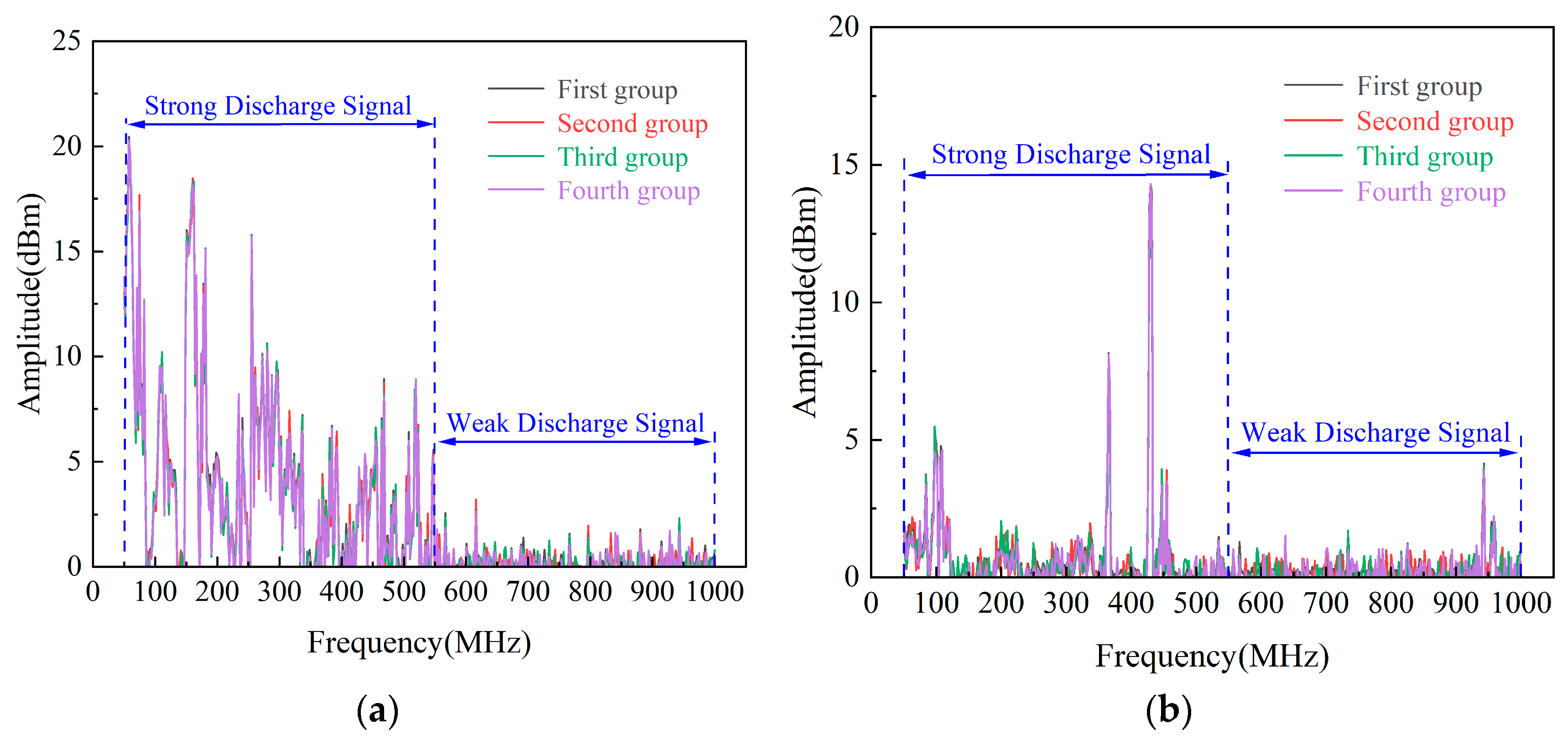
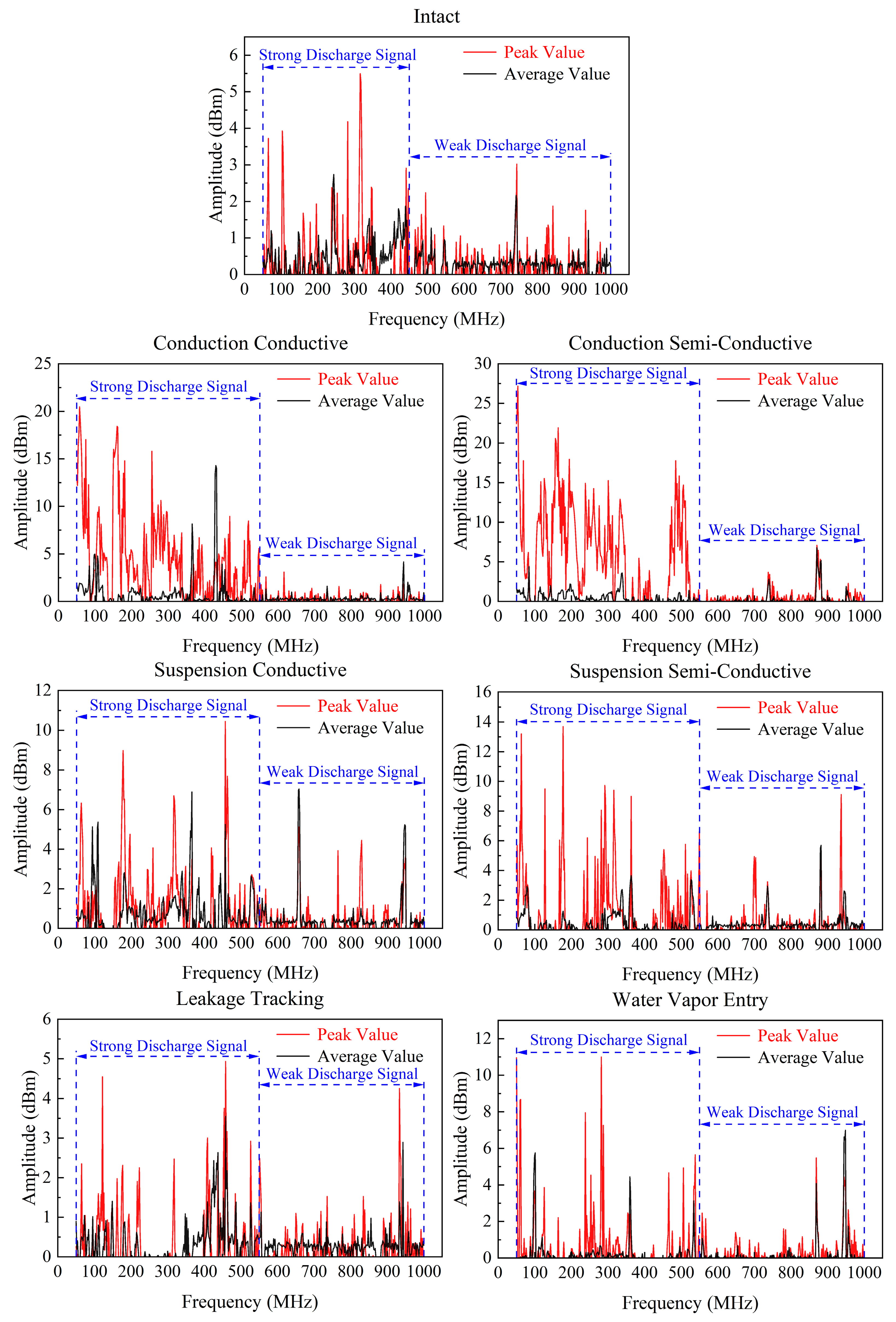
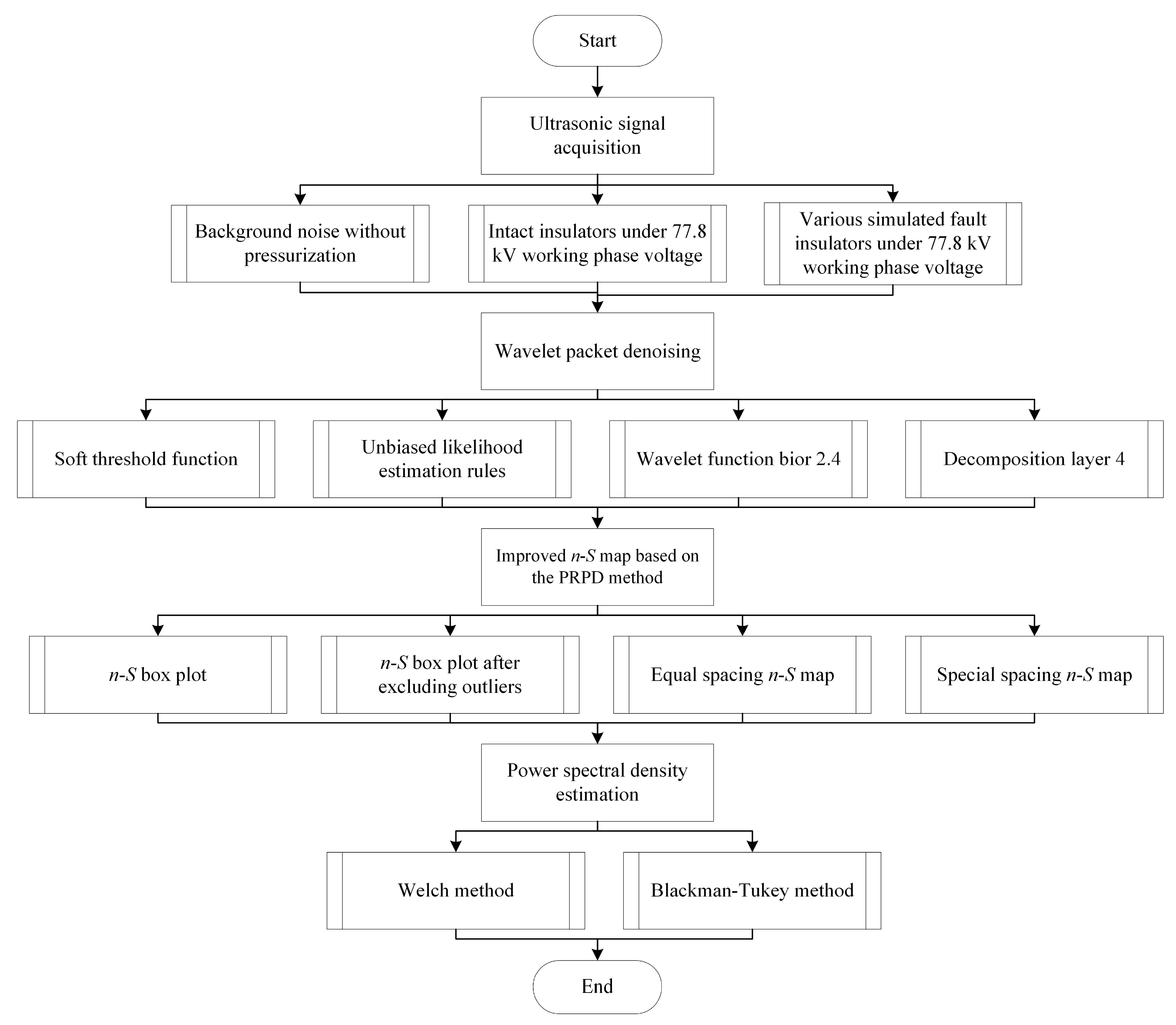


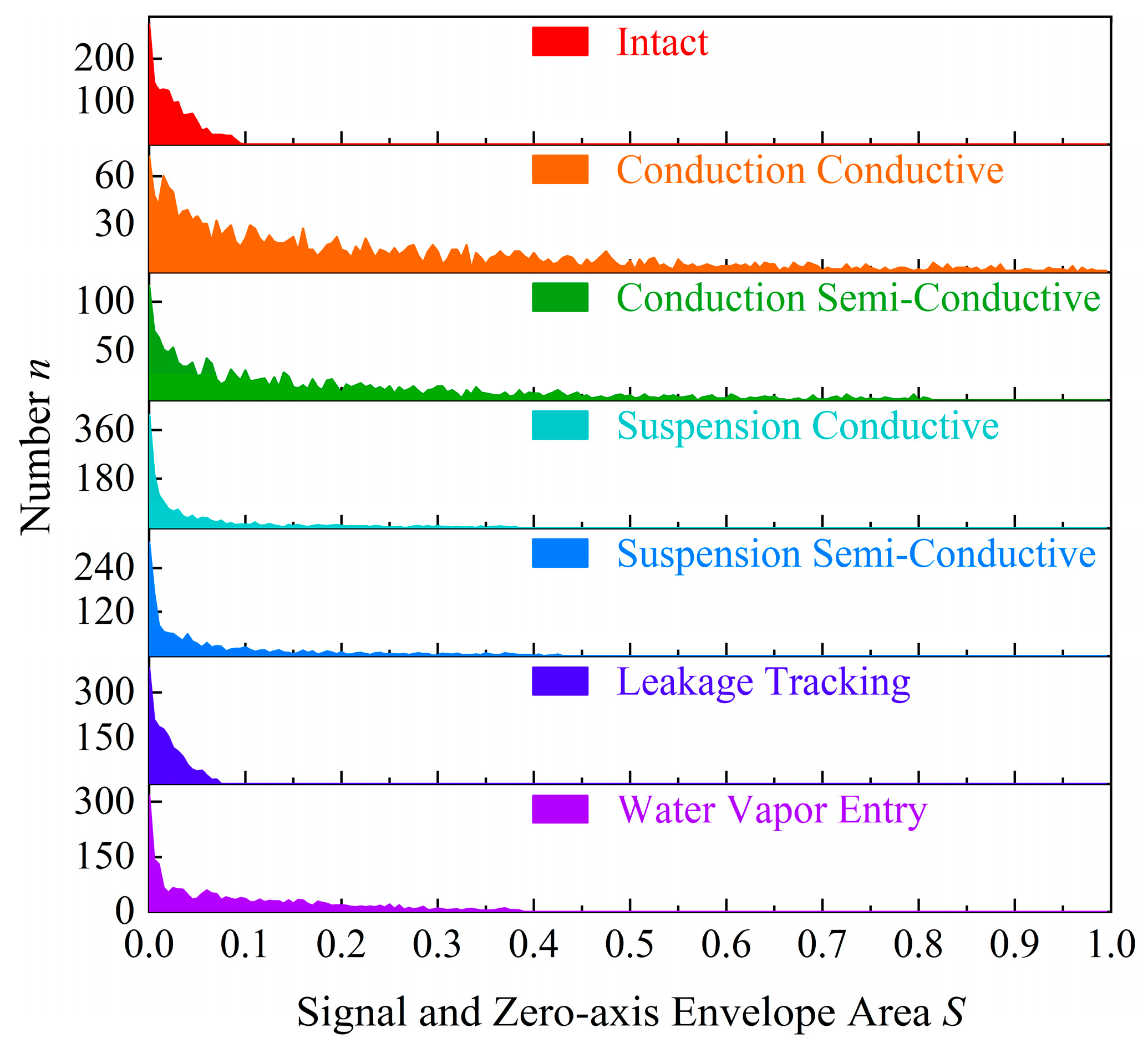


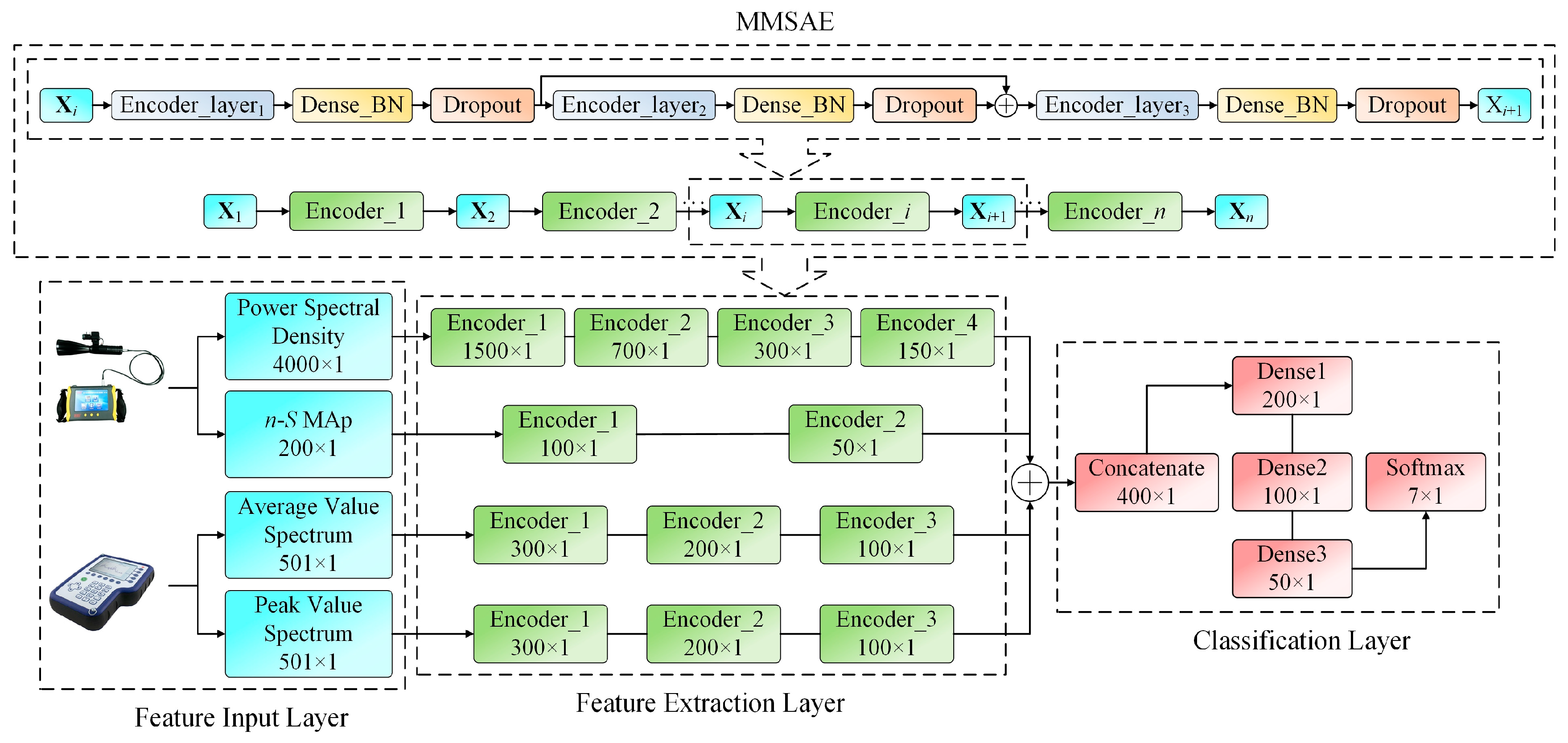
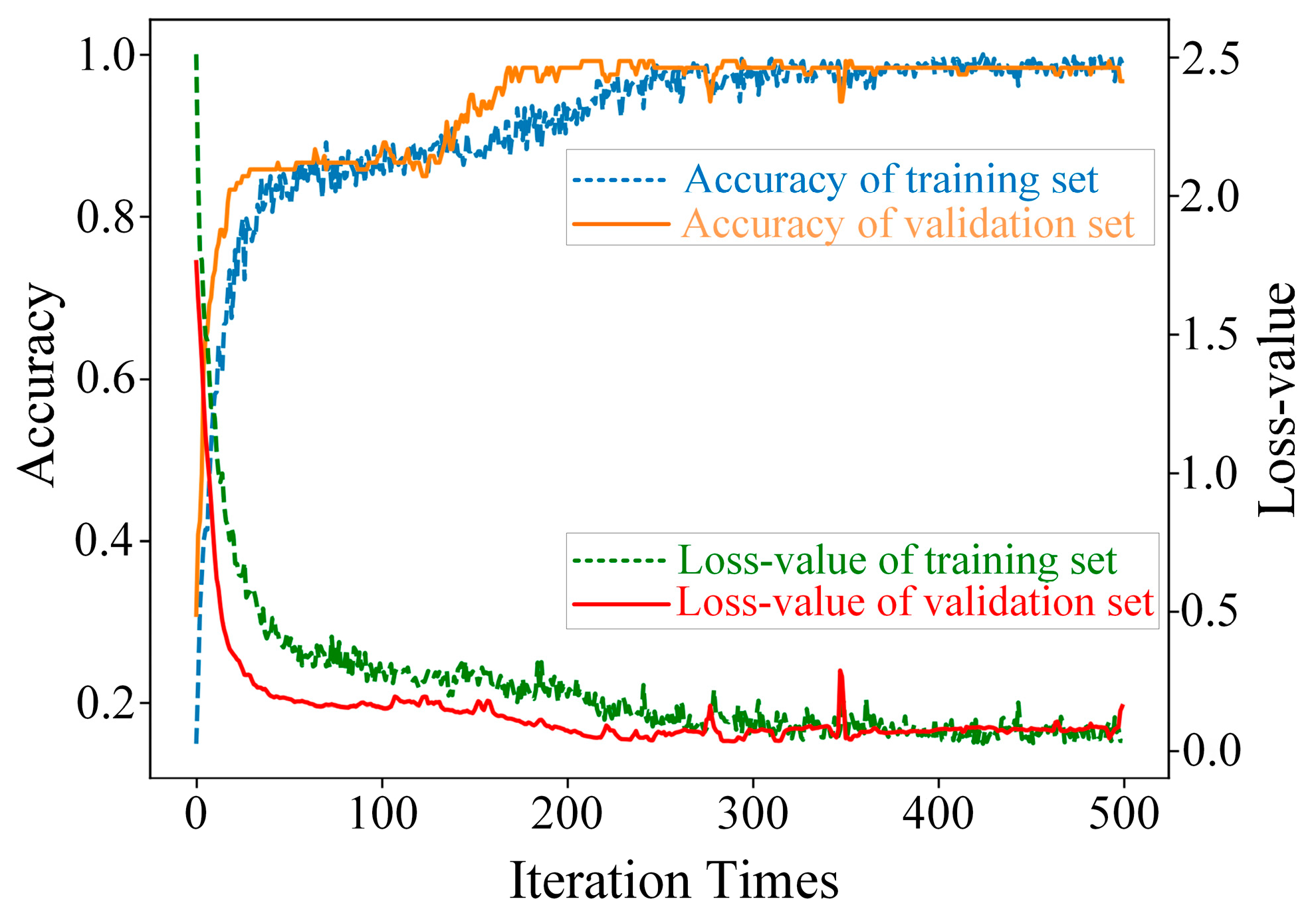
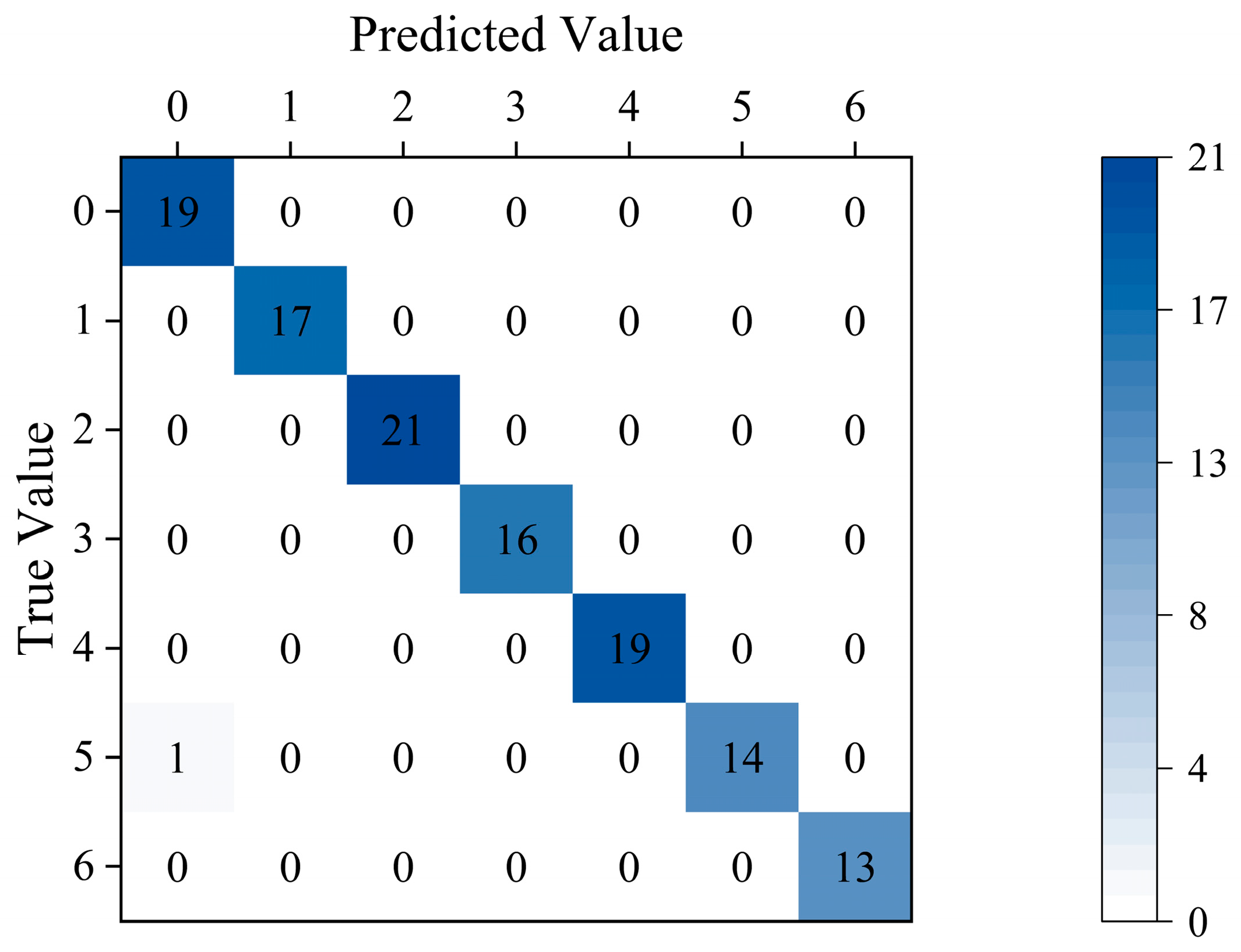

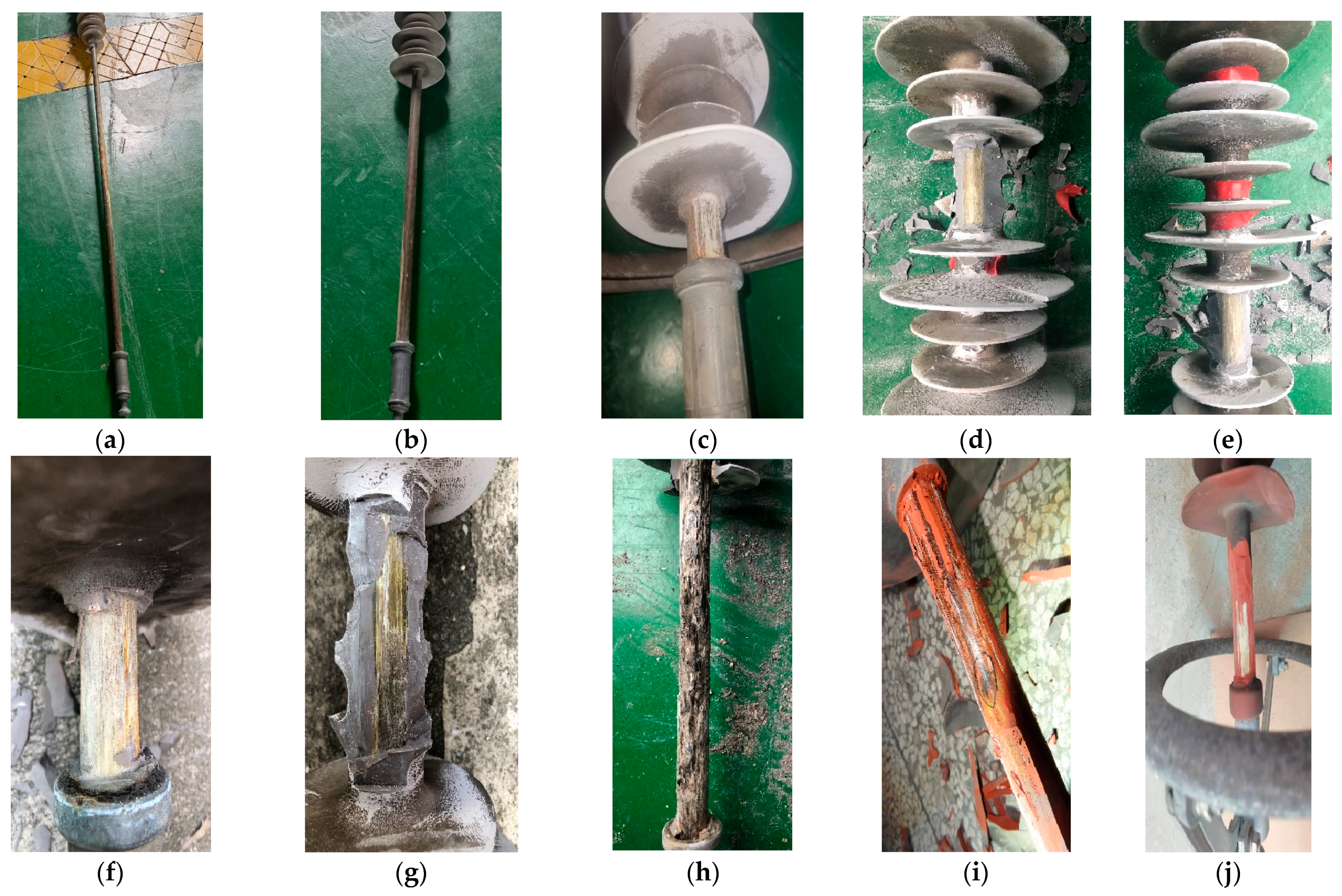
| Defect Type | Starting Position | Simulated Material |
|---|---|---|
| Intact | ||
| Conduction conductive | High-voltage end metal fittings | Copper wire |
| Conduction semi-conductive | Carbon rod | |
| Water vapor entry | Salt solution | |
| Suspension conductive | High-voltage end first umbrella skirt | Copper wire |
| Suspension semi-conductive | Carbon rod | |
| Leakage tracking | Carbon powder |
| Area S | Variance | Skewness | Kurtosis |
|---|---|---|---|
| Intact | 0.0005 | 0.90 | 3.10 |
| Conduction conductive | 0.0561 | 1.14 | 3.55 |
| Conduction semi-conductive | 0.0362 | 1.27 | 3.97 |
| Suspension conductive | 0.0076 | 1.85 | 5.72 |
| Suspension semi-conductive | 0.0100 | 1.61 | 4.77 |
| Leakage tracking | 0.0003 | 0.92 | 3.13 |
| Water vapor entry | 0.0092 | 1.04 | 3.26 |
| Number | Type | Data Quantity |
|---|---|---|
| 0 | Intact | 72 |
| 1 | Conduction conductive | 120 |
| 2 | Conduction semi-conductive | 120 |
| 3 | Suspension conductive | 72 |
| 4 | Suspension semi-conductive | 72 |
| 5 | Leakage tracking | 72 |
| 6 | Water vapor entry | 72 |
| Defect Type | Index | MMSAE | ANN | ||||
|---|---|---|---|---|---|---|---|
| Fusion (%) | Ultrasonic (%) | Electromagnetic Wave (%) | Fusion (%) | Ultrasonic (%) | Electromagnetic Wave (%) | ||
| 0 | Recall | 95 | 82.35 | 90 | 86.36 | 50 | 85 |
| Precision | 100 | 73.68 | 94.74 | 100 | 31.58 | 89.47 | |
| F1-score | 97.44 | 77.78 | 92.31 | 92.68 | 38.71 | 87.18 | |
| 1 | Recall | 100 | 100 | 100 | 100 | 100 | 100 |
| Precision | 100 | 94.12 | 100 | 100 | 100 | 100 | |
| F1-score | 100 | 96.97 | 100 | 100 | 100 | 100 | |
| 2 | Recall | 100 | 100 | 100 | 100 | 100 | 100 |
| Precision | 100 | 100 | 100 | 100 | 100 | 100 | |
| F1-score | 100 | 100 | 100 | 100 | 100 | 100 | |
| 3 | Recall | 100 | 84.21 | 100 | 100 | 100 | 100 |
| Precision | 100 | 100 | 100 | 100 | 100 | 100 | |
| F1-score | 100 | 91.43 | 100 | 100 | 100 | 100 | |
| 4 | Recall | 100 | 76.92 | 100 | 100 | 68.75 | 100 |
| Precision | 100 | 52.63 | 100 | 100 | 57.89 | 100 | |
| F1-score | 100 | 62.50 | 100 | 100 | 62.86 | 100 | |
| 5 | Recall | 100 | 70.59 | 92.86 | 92.31 | 40.91 | 85.71 |
| Precision | 93.33 | 80 | 86.67 | 80 | 60 | 80 | |
| F1-score | 96.55 | 75 | 89.66 | 85.71 | 48.65 | 82.76 | |
| 6 | Recall | 100 | 47.06 | 100 | 100 | 50 | 100 |
| Precision | 100 | 61.54 | 100 | 92.31 | 61.54 | 100 | |
| F1-score | 100 | 53.33 | 100 | 96 | 55.17 | 100 | |
| Total accuracy | 99.17 | 80.83 | 97.5 | 96.67 | 73.30 | 95.83 | |
| No. | Software Diagnostics | Dissection Verification |
|---|---|---|
| 1 | Conduction conductive | Conduction conductive |
| 2 | Conduction semi-conductive | Conduction semi-conductive |
| 3 | Water vapor entry | Water vapor entry |
| 4 | Suspension conductive | Suspension conductive |
| 5 | Suspension semi-conductive | Suspension semi-conductive |
| 6 | Water vapor entry | Water vapor entry |
| 7 | Water vapor entry | Water vapor entry |
| 8 | Conduction conductive | Conduction conductive |
| 9 | Leakage tracking | Leakage tracking |
| 10 | Conduction semi-conductive | Conduction semi-conductive |
Disclaimer/Publisher’s Note: The statements, opinions and data contained in all publications are solely those of the individual author(s) and contributor(s) and not of MDPI and/or the editor(s). MDPI and/or the editor(s) disclaim responsibility for any injury to people or property resulting from any ideas, methods, instructions or products referred to in the content. |
© 2023 by the authors. Licensee MDPI, Basel, Switzerland. This article is an open access article distributed under the terms and conditions of the Creative Commons Attribution (CC BY) license (https://creativecommons.org/licenses/by/4.0/).
Share and Cite
Zhang, B.; Shu, S.; Chen, C.; Wang, X.; Xu, J.; Fang, C. Composite Insulator Defect Identification Method Based on Acoustic–Electric Feature Fusion and MMSAE Network. Energies 2023, 16, 4906. https://doi.org/10.3390/en16134906
Zhang B, Shu S, Chen C, Wang X, Xu J, Fang C. Composite Insulator Defect Identification Method Based on Acoustic–Electric Feature Fusion and MMSAE Network. Energies. 2023; 16(13):4906. https://doi.org/10.3390/en16134906
Chicago/Turabian StyleZhang, Bizhen, Shengwen Shu, Cheng Chen, Xiaojie Wang, Jun Xu, and Chaoying Fang. 2023. "Composite Insulator Defect Identification Method Based on Acoustic–Electric Feature Fusion and MMSAE Network" Energies 16, no. 13: 4906. https://doi.org/10.3390/en16134906






